In-depth Analysis: Margaret Laurence's 'The Loons' - EAC 150 Essay
VerifiedAdded on 2023/06/11
|7
|1246
|88
Essay
AI Summary
This essay presents an analysis of Margaret Laurence's "The Loons," focusing on its themes, characters, and social commentary. The analysis covers the portrayal of the village, the social status of its dwellers, and the impact of racism. It explores the significance of characters like Piquette Tonnerre, Doctor Ewen, and Grandmother Macleod, and examines the symbolism within the story, including the renaming of Diamond Lake. The essay also discusses the narrator's expectations and disappointments, Piquette's tragic circumstances, and the ironic implications of cultural appropriation. The conclusion emphasizes the mocking and plaintive qualities of the loons' sounds, reflecting Piquette's experiences and the overall themes of the story. Explore more solved assignments and study resources on Desklib.
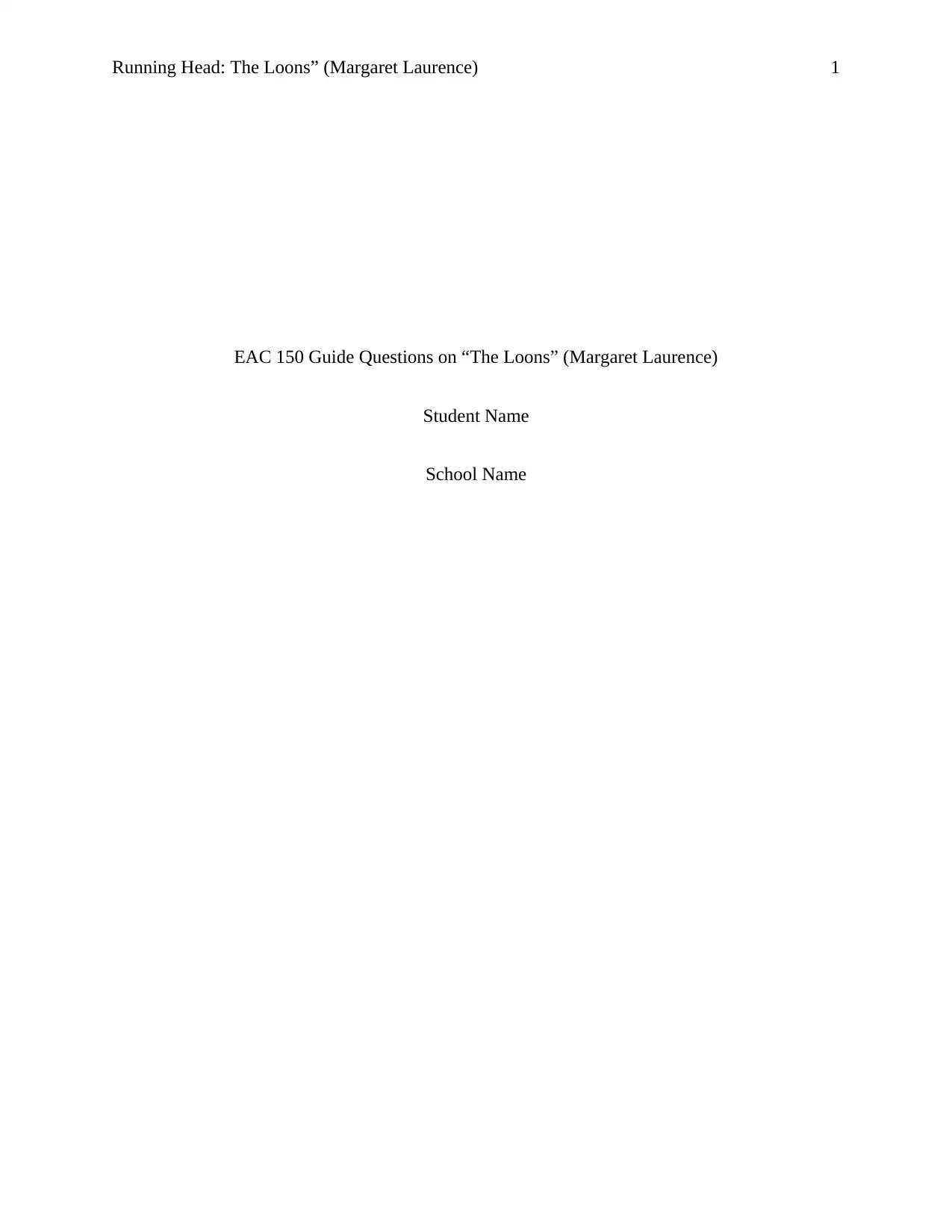
Running Head: The Loons” (Margaret Laurence) 1
EAC 150 Guide Questions on “The Loons” (Margaret Laurence)
Student Name
School Name
EAC 150 Guide Questions on “The Loons” (Margaret Laurence)
Student Name
School Name
Paraphrase This Document
Need a fresh take? Get an instant paraphrase of this document with our AI Paraphraser
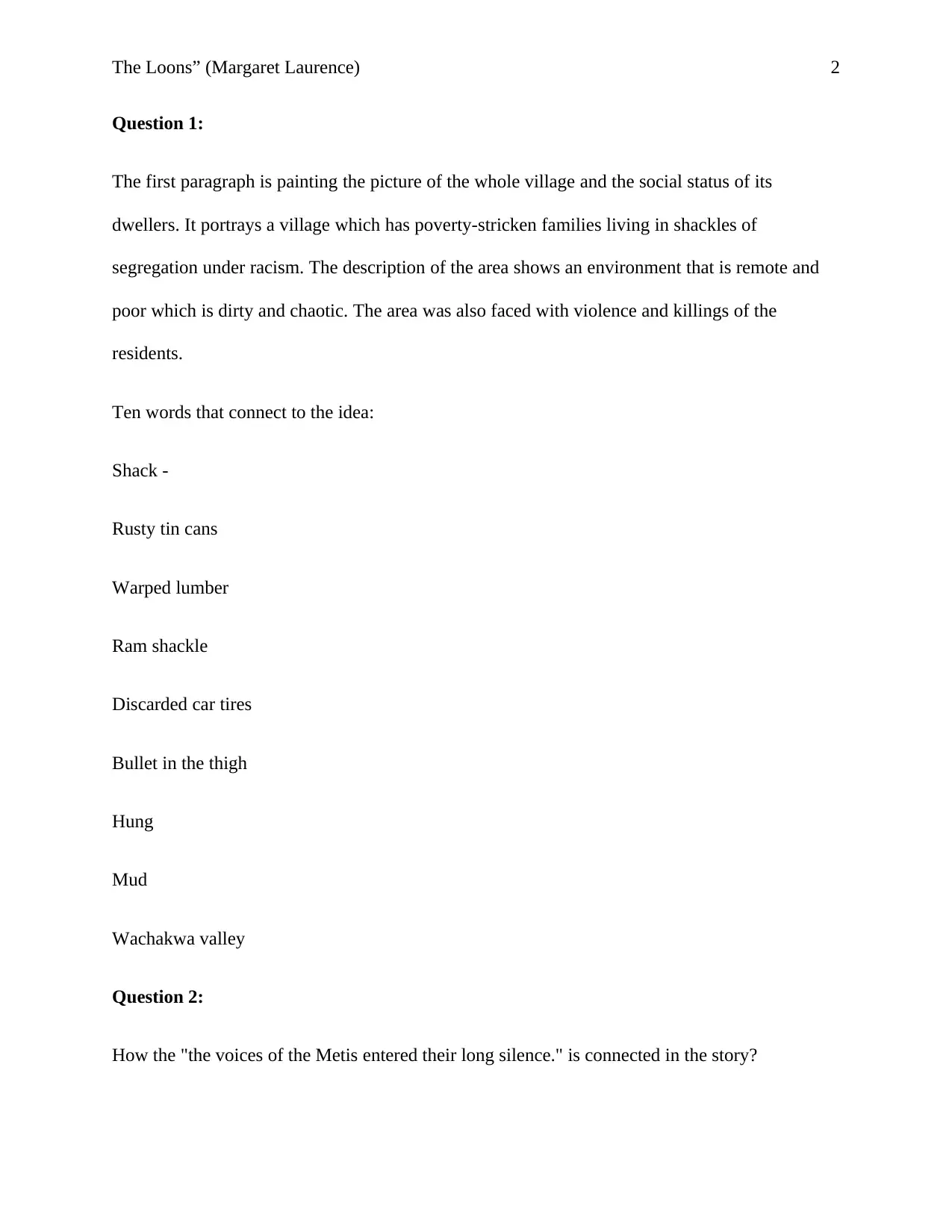
The Loons” (Margaret Laurence) 2
Question 1:
The first paragraph is painting the picture of the whole village and the social status of its
dwellers. It portrays a village which has poverty-stricken families living in shackles of
segregation under racism. The description of the area shows an environment that is remote and
poor which is dirty and chaotic. The area was also faced with violence and killings of the
residents.
Ten words that connect to the idea:
Shack -
Rusty tin cans
Warped lumber
Ram shackle
Discarded car tires
Bullet in the thigh
Hung
Mud
Wachakwa valley
Question 2:
How the "the voices of the Metis entered their long silence." is connected in the story?
Question 1:
The first paragraph is painting the picture of the whole village and the social status of its
dwellers. It portrays a village which has poverty-stricken families living in shackles of
segregation under racism. The description of the area shows an environment that is remote and
poor which is dirty and chaotic. The area was also faced with violence and killings of the
residents.
Ten words that connect to the idea:
Shack -
Rusty tin cans
Warped lumber
Ram shackle
Discarded car tires
Bullet in the thigh
Hung
Mud
Wachakwa valley
Question 2:
How the "the voices of the Metis entered their long silence." is connected in the story?
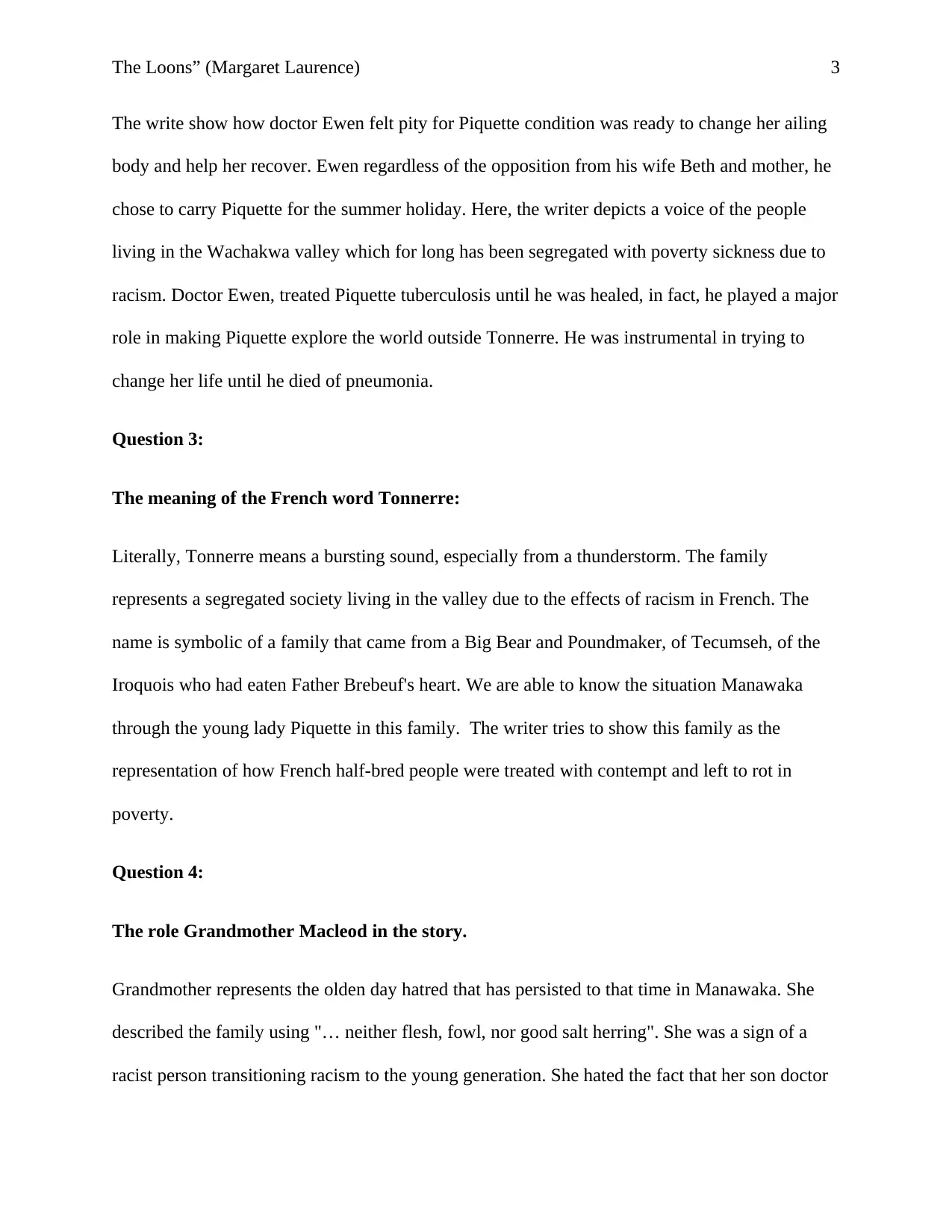
The Loons” (Margaret Laurence) 3
The write show how doctor Ewen felt pity for Piquette condition was ready to change her ailing
body and help her recover. Ewen regardless of the opposition from his wife Beth and mother, he
chose to carry Piquette for the summer holiday. Here, the writer depicts a voice of the people
living in the Wachakwa valley which for long has been segregated with poverty sickness due to
racism. Doctor Ewen, treated Piquette tuberculosis until he was healed, in fact, he played a major
role in making Piquette explore the world outside Tonnerre. He was instrumental in trying to
change her life until he died of pneumonia.
Question 3:
The meaning of the French word Tonnerre:
Literally, Tonnerre means a bursting sound, especially from a thunderstorm. The family
represents a segregated society living in the valley due to the effects of racism in French. The
name is symbolic of a family that came from a Big Bear and Poundmaker, of Tecumseh, of the
Iroquois who had eaten Father Brebeuf's heart. We are able to know the situation Manawaka
through the young lady Piquette in this family. The writer tries to show this family as the
representation of how French half-bred people were treated with contempt and left to rot in
poverty.
Question 4:
The role Grandmother Macleod in the story.
Grandmother represents the olden day hatred that has persisted to that time in Manawaka. She
described the family using "… neither flesh, fowl, nor good salt herring". She was a sign of a
racist person transitioning racism to the young generation. She hated the fact that her son doctor
The write show how doctor Ewen felt pity for Piquette condition was ready to change her ailing
body and help her recover. Ewen regardless of the opposition from his wife Beth and mother, he
chose to carry Piquette for the summer holiday. Here, the writer depicts a voice of the people
living in the Wachakwa valley which for long has been segregated with poverty sickness due to
racism. Doctor Ewen, treated Piquette tuberculosis until he was healed, in fact, he played a major
role in making Piquette explore the world outside Tonnerre. He was instrumental in trying to
change her life until he died of pneumonia.
Question 3:
The meaning of the French word Tonnerre:
Literally, Tonnerre means a bursting sound, especially from a thunderstorm. The family
represents a segregated society living in the valley due to the effects of racism in French. The
name is symbolic of a family that came from a Big Bear and Poundmaker, of Tecumseh, of the
Iroquois who had eaten Father Brebeuf's heart. We are able to know the situation Manawaka
through the young lady Piquette in this family. The writer tries to show this family as the
representation of how French half-bred people were treated with contempt and left to rot in
poverty.
Question 4:
The role Grandmother Macleod in the story.
Grandmother represents the olden day hatred that has persisted to that time in Manawaka. She
described the family using "… neither flesh, fowl, nor good salt herring". She was a sign of a
racist person transitioning racism to the young generation. She hated the fact that her son doctor
⊘ This is a preview!⊘
Do you want full access?
Subscribe today to unlock all pages.

Trusted by 1+ million students worldwide
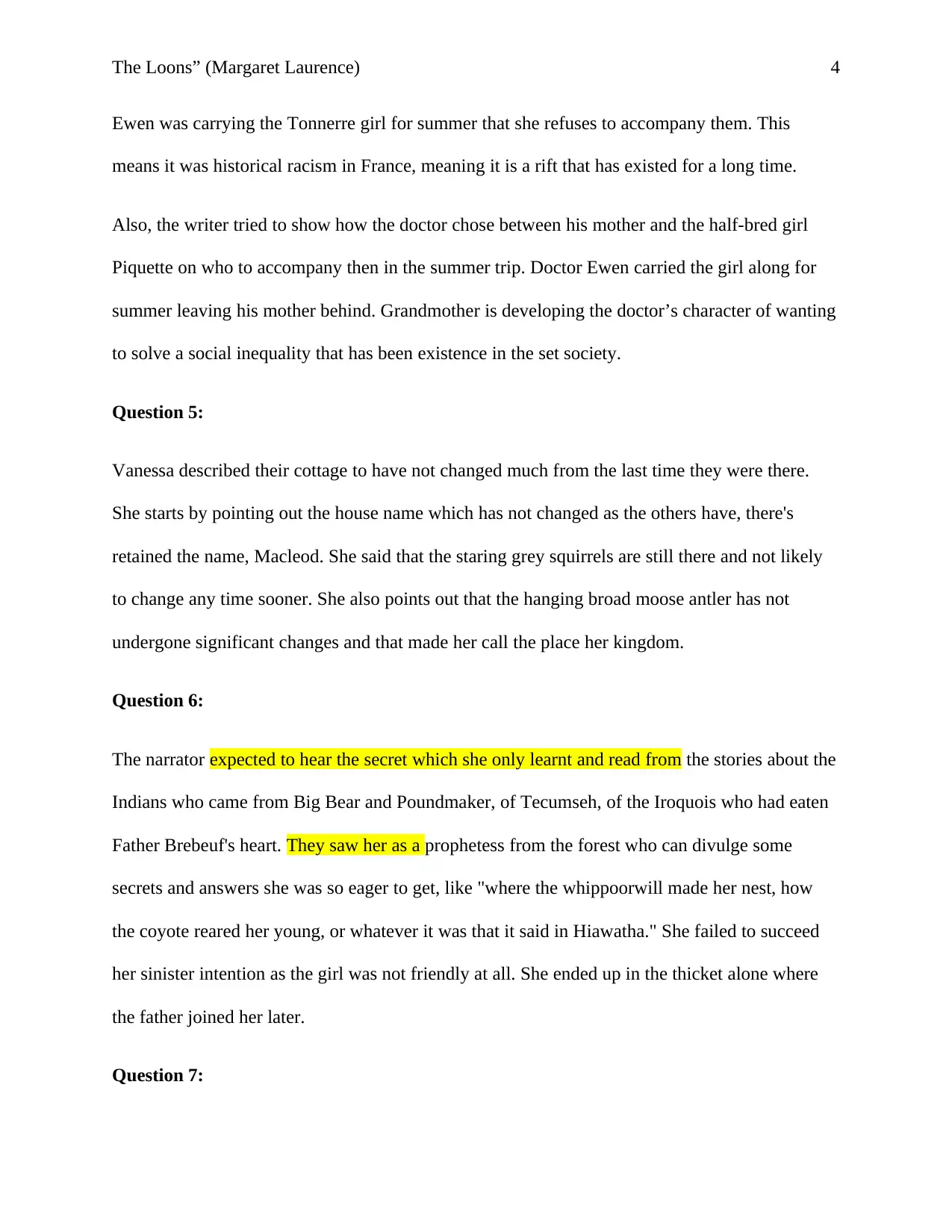
The Loons” (Margaret Laurence) 4
Ewen was carrying the Tonnerre girl for summer that she refuses to accompany them. This
means it was historical racism in France, meaning it is a rift that has existed for a long time.
Also, the writer tried to show how the doctor chose between his mother and the half-bred girl
Piquette on who to accompany then in the summer trip. Doctor Ewen carried the girl along for
summer leaving his mother behind. Grandmother is developing the doctor’s character of wanting
to solve a social inequality that has been existence in the set society.
Question 5:
Vanessa described their cottage to have not changed much from the last time they were there.
She starts by pointing out the house name which has not changed as the others have, there's
retained the name, Macleod. She said that the staring grey squirrels are still there and not likely
to change any time sooner. She also points out that the hanging broad moose antler has not
undergone significant changes and that made her call the place her kingdom.
Question 6:
The narrator expected to hear the secret which she only learnt and read from the stories about the
Indians who came from Big Bear and Poundmaker, of Tecumseh, of the Iroquois who had eaten
Father Brebeuf's heart. They saw her as a prophetess from the forest who can divulge some
secrets and answers she was so eager to get, like "where the whippoorwill made her nest, how
the coyote reared her young, or whatever it was that it said in Hiawatha." She failed to succeed
her sinister intention as the girl was not friendly at all. She ended up in the thicket alone where
the father joined her later.
Question 7:
Ewen was carrying the Tonnerre girl for summer that she refuses to accompany them. This
means it was historical racism in France, meaning it is a rift that has existed for a long time.
Also, the writer tried to show how the doctor chose between his mother and the half-bred girl
Piquette on who to accompany then in the summer trip. Doctor Ewen carried the girl along for
summer leaving his mother behind. Grandmother is developing the doctor’s character of wanting
to solve a social inequality that has been existence in the set society.
Question 5:
Vanessa described their cottage to have not changed much from the last time they were there.
She starts by pointing out the house name which has not changed as the others have, there's
retained the name, Macleod. She said that the staring grey squirrels are still there and not likely
to change any time sooner. She also points out that the hanging broad moose antler has not
undergone significant changes and that made her call the place her kingdom.
Question 6:
The narrator expected to hear the secret which she only learnt and read from the stories about the
Indians who came from Big Bear and Poundmaker, of Tecumseh, of the Iroquois who had eaten
Father Brebeuf's heart. They saw her as a prophetess from the forest who can divulge some
secrets and answers she was so eager to get, like "where the whippoorwill made her nest, how
the coyote reared her young, or whatever it was that it said in Hiawatha." She failed to succeed
her sinister intention as the girl was not friendly at all. She ended up in the thicket alone where
the father joined her later.
Question 7:
Paraphrase This Document
Need a fresh take? Get an instant paraphrase of this document with our AI Paraphraser
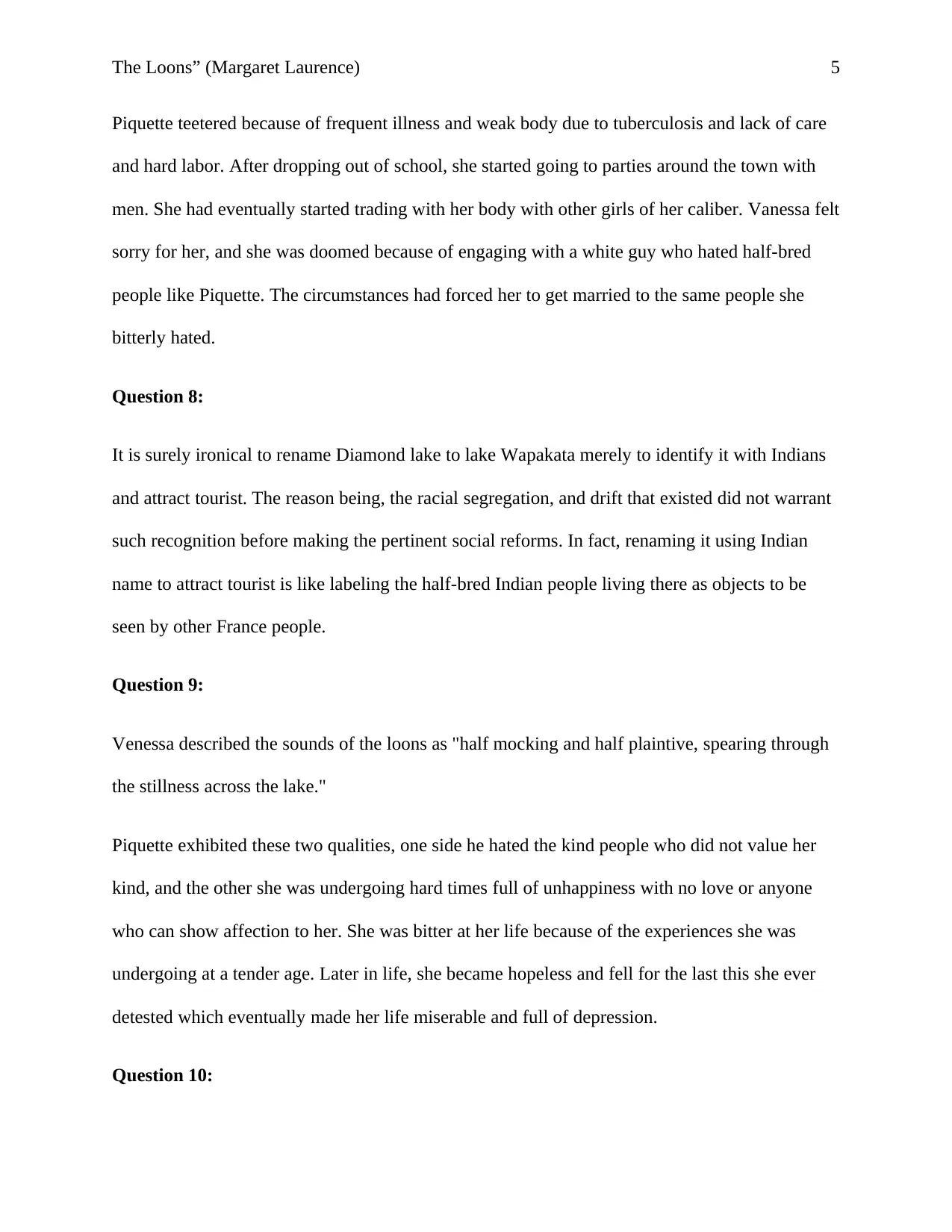
The Loons” (Margaret Laurence) 5
Piquette teetered because of frequent illness and weak body due to tuberculosis and lack of care
and hard labor. After dropping out of school, she started going to parties around the town with
men. She had eventually started trading with her body with other girls of her caliber. Vanessa felt
sorry for her, and she was doomed because of engaging with a white guy who hated half-bred
people like Piquette. The circumstances had forced her to get married to the same people she
bitterly hated.
Question 8:
It is surely ironical to rename Diamond lake to lake Wapakata merely to identify it with Indians
and attract tourist. The reason being, the racial segregation, and drift that existed did not warrant
such recognition before making the pertinent social reforms. In fact, renaming it using Indian
name to attract tourist is like labeling the half-bred Indian people living there as objects to be
seen by other France people.
Question 9:
Venessa described the sounds of the loons as "half mocking and half plaintive, spearing through
the stillness across the lake."
Piquette exhibited these two qualities, one side he hated the kind people who did not value her
kind, and the other she was undergoing hard times full of unhappiness with no love or anyone
who can show affection to her. She was bitter at her life because of the experiences she was
undergoing at a tender age. Later in life, she became hopeless and fell for the last this she ever
detested which eventually made her life miserable and full of depression.
Question 10:
Piquette teetered because of frequent illness and weak body due to tuberculosis and lack of care
and hard labor. After dropping out of school, she started going to parties around the town with
men. She had eventually started trading with her body with other girls of her caliber. Vanessa felt
sorry for her, and she was doomed because of engaging with a white guy who hated half-bred
people like Piquette. The circumstances had forced her to get married to the same people she
bitterly hated.
Question 8:
It is surely ironical to rename Diamond lake to lake Wapakata merely to identify it with Indians
and attract tourist. The reason being, the racial segregation, and drift that existed did not warrant
such recognition before making the pertinent social reforms. In fact, renaming it using Indian
name to attract tourist is like labeling the half-bred Indian people living there as objects to be
seen by other France people.
Question 9:
Venessa described the sounds of the loons as "half mocking and half plaintive, spearing through
the stillness across the lake."
Piquette exhibited these two qualities, one side he hated the kind people who did not value her
kind, and the other she was undergoing hard times full of unhappiness with no love or anyone
who can show affection to her. She was bitter at her life because of the experiences she was
undergoing at a tender age. Later in life, she became hopeless and fell for the last this she ever
detested which eventually made her life miserable and full of depression.
Question 10:
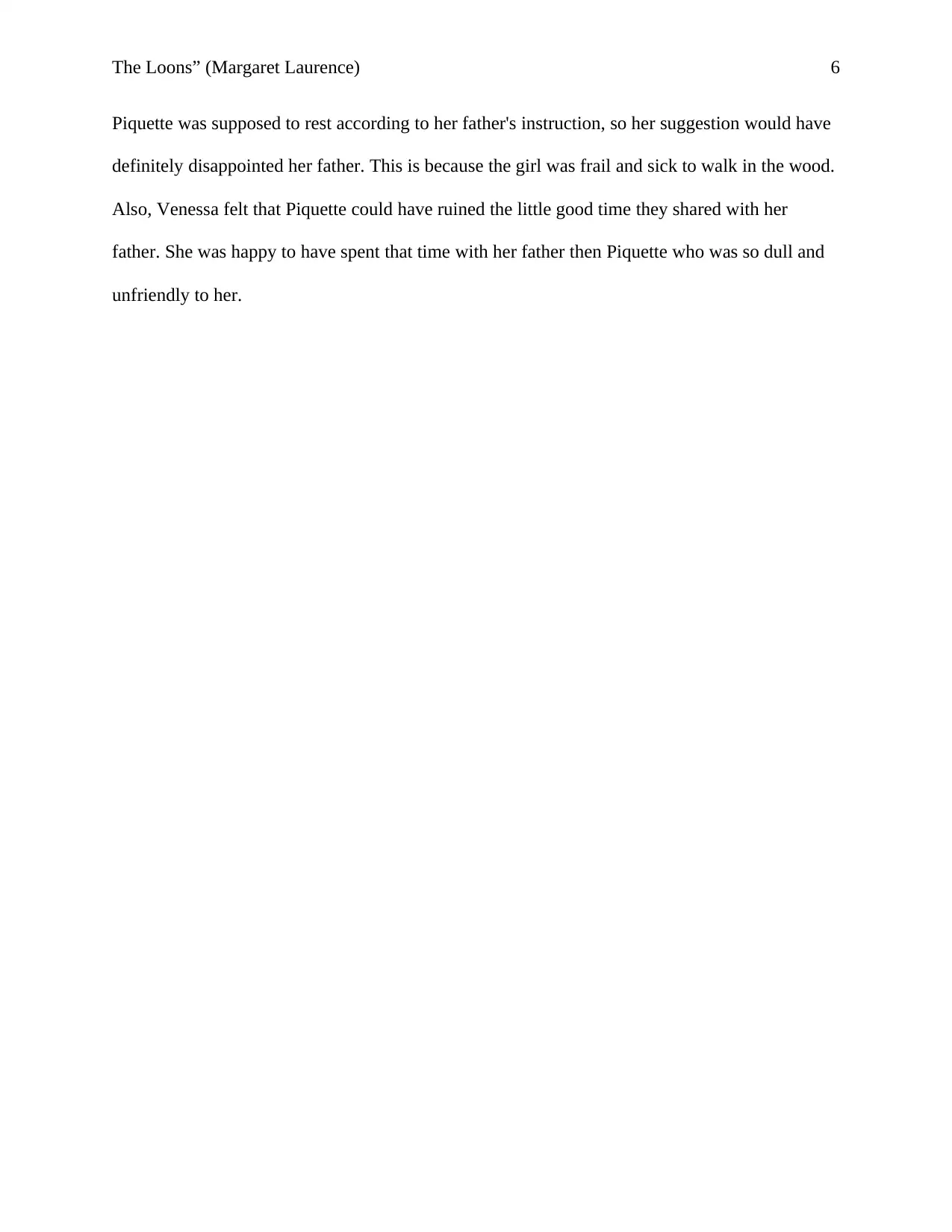
The Loons” (Margaret Laurence) 6
Piquette was supposed to rest according to her father's instruction, so her suggestion would have
definitely disappointed her father. This is because the girl was frail and sick to walk in the wood.
Also, Venessa felt that Piquette could have ruined the little good time they shared with her
father. She was happy to have spent that time with her father then Piquette who was so dull and
unfriendly to her.
Piquette was supposed to rest according to her father's instruction, so her suggestion would have
definitely disappointed her father. This is because the girl was frail and sick to walk in the wood.
Also, Venessa felt that Piquette could have ruined the little good time they shared with her
father. She was happy to have spent that time with her father then Piquette who was so dull and
unfriendly to her.
⊘ This is a preview!⊘
Do you want full access?
Subscribe today to unlock all pages.

Trusted by 1+ million students worldwide
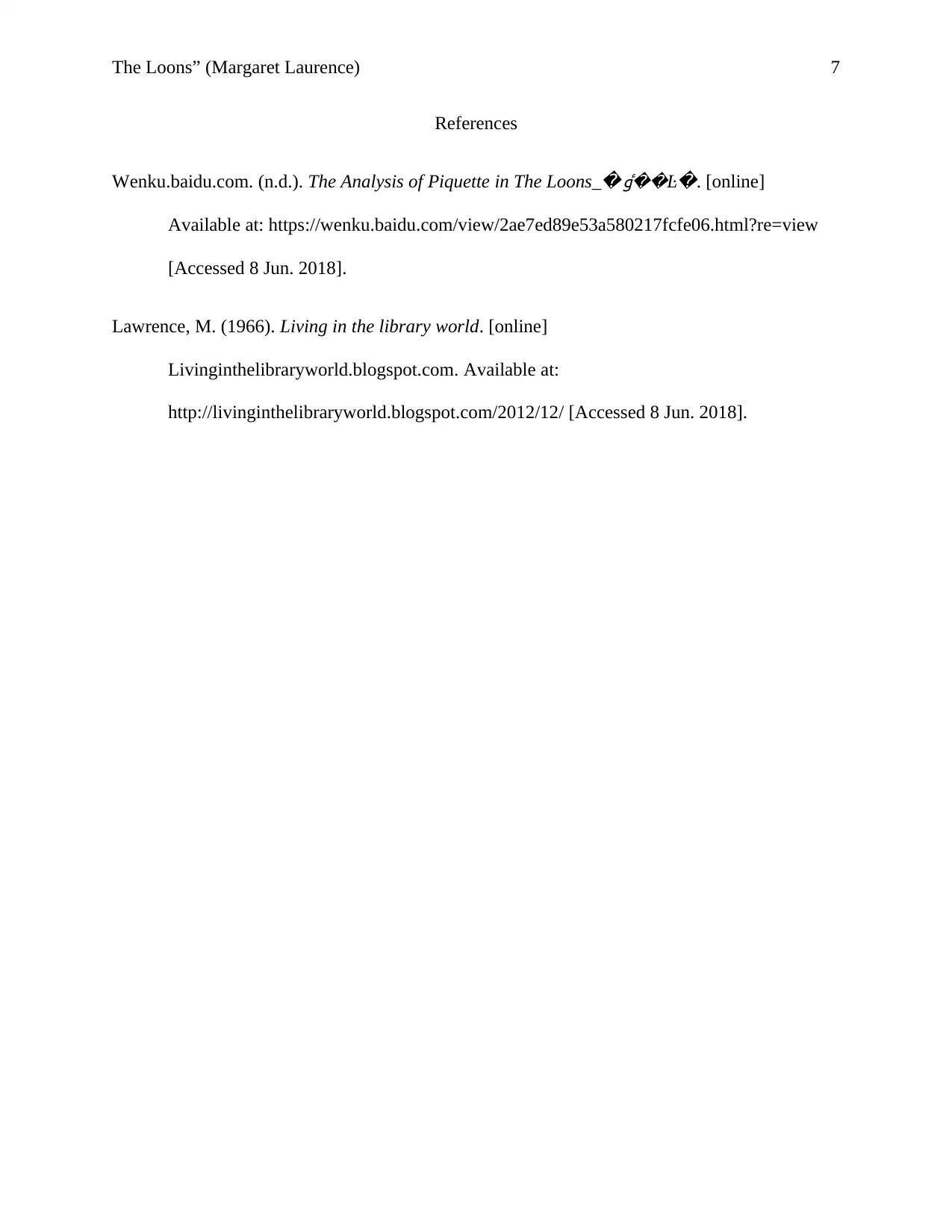
The Loons” (Margaret Laurence) 7
References
Wenku.baidu.com. (n.d.). The Analysis of Piquette in The Loons_�
ٶ��Ŀ�. [online]
Available at: https://wenku.baidu.com/view/2ae7ed89e53a580217fcfe06.html?re=view
[Accessed 8 Jun. 2018].
Lawrence, M. (1966). Living in the library world. [online]
Livinginthelibraryworld.blogspot.com. Available at:
http://livinginthelibraryworld.blogspot.com/2012/12/ [Accessed 8 Jun. 2018].
References
Wenku.baidu.com. (n.d.). The Analysis of Piquette in The Loons_�
ٶ��Ŀ�. [online]
Available at: https://wenku.baidu.com/view/2ae7ed89e53a580217fcfe06.html?re=view
[Accessed 8 Jun. 2018].
Lawrence, M. (1966). Living in the library world. [online]
Livinginthelibraryworld.blogspot.com. Available at:
http://livinginthelibraryworld.blogspot.com/2012/12/ [Accessed 8 Jun. 2018].
1 out of 7
Your All-in-One AI-Powered Toolkit for Academic Success.
+13062052269
info@desklib.com
Available 24*7 on WhatsApp / Email
![[object Object]](/_next/static/media/star-bottom.7253800d.svg)
Unlock your academic potential
Copyright © 2020–2025 A2Z Services. All Rights Reserved. Developed and managed by ZUCOL.